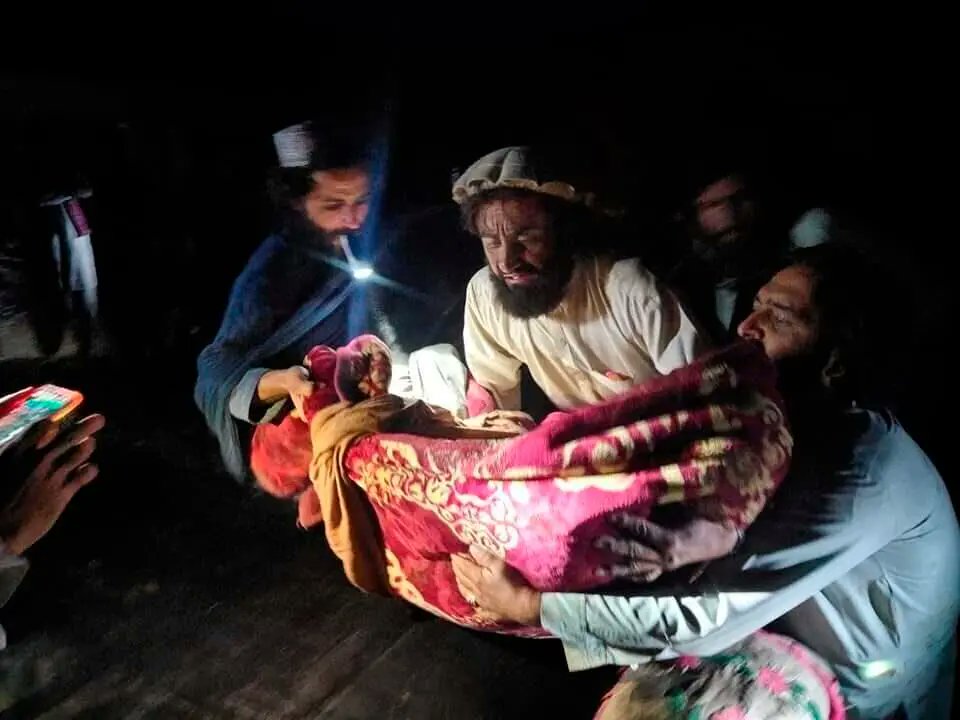22/06/2022
22/06/2022
KABUL, June 22, (AP): A powerful earthquake struck a rugged, mountainous region of eastern Afghanistan early Wednesday, flattening stone and mudbrick homes and killing at least 1,000 people in the country’s deadliest quake in two decades, the state-run news agency reported. An estimated 1,500 others were reported injured, and officials said the death toll could rise. The disaster inflicted by the 6.1-magnitude quake posed a major test for Afghanistan’s Taliban government, which retook power nearly 10 months ago as the U.S. and its NATO allies withdrew from the country and has been largely shunned by the rest of the world since. In a rare move, the Taliban’s supreme leader, Haibatullah Akhundzadah, who almost never appears in public, pleaded with the international community and humanitarian organizations “to help the Afghan people affected by this great tragedy and to spare no effort to help the affected people.”

Residents in the remote area near the Pakistani border searched for victims dead or alive by digging with their bare hands through the rubble, according to footage shown by the Bakhtar news agency. It was not immediately clear if heavy rescue equipment was being sent, or even if it could reach the area. At least 2,000 homes were destroyed in the region, where on average every home has seven or eight people living in it, said Ramiz Alakbarov, the U.N. deputy special representative to Afghanistan.
The full extent of the destruction among the villages tucked in the mountains was slow in coming to light. Rutted roads - difficult to pass in the best of times - may have been badly damaged, and landslides from recent rains made access even more difficult. Rescuers rushed in by helicopter, but the relief effort could be hindered by the exodus of many international aid agencies from Afghanistan after the Taliban takeover last August. Moreover, most governments are wary of dealing directly with the Taliban. In a sign of the muddled workings between the Taliban and the rest of the world, Alakbarov said the Taliban had not formally requested that the U.N. mobilize international search-and-rescue teams or obtain equipment from neighboring countries to supplement the few dozen ambulances and several helicopters sent in by Afghan authorities. The disaster only compounds the misery in Afghanistan, which is already deep in one of the world’s worst humanitarian crises, with millions facing increasing hunger and poverty after the cutoff of international financing to the Taliban. That has prompted a huge aid program, but to avoid putting money in the Taliban’s hands, the world has funneled funding through the U.N. and other humanitarian agencies, a system that may be too slow for an emergency response to the quake. The quake was centered in Paktika province, about 50 kilometers (31 miles) southwest of the city of Khost, according to neighboring Pakistan’s Meteorological Department.
Experts put its depth at just 10 kilometers (6 miles). Shallow earthquakes tend to cause more damage. The European seismological agency said the quake was felt over 500 kilometers (310 miles) by 119 million people across Afghanistan, Pakistan and India. Footage from Paktika showed men carrying people in blankets to a waiting helicopter. Other victims were treated on the ground. One person could be seen receiving IV fluids while sitting in a plastic chair outside the rubble of his home, and still more were sprawled on gurneys. Some images showed residents picking through clay bricks and other rubble. Roofs and walls had caved in. The death toll was equal to that of a quake in 2002 in northern Afghanistan. Those are the deadliest since 1998, when an earthquake that was also 6.1 in magnitude and subsequent tremors in the remote northeast killed at least 4,500 people.
Wednesday’s quake took place in a region prone to landslides, with many older buildings likely to crumble. “The fear is that the victims will increase further, also because many people could be trapped under collapsed buildings,” said Stefano Sozza, Afghanistan country director for the Italian medical aid group Emergency. Emergency, which was dispensing humanitarian aid in Afghanistan before the disaster, sent seven ambulances and staff to areas near the quake zone. The children’s agency UNICEF had health and nutrition teams in the area and sent truckloads of blankets, tents and other supplies, Sam Mort, communications chief for UNICEF Afghanistan, told British broadcaster Sky. Hospitals in the region were overwhelmed with the injured, she said.


